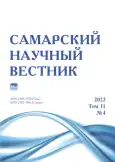The development of an adaptive response of Drosophila melanogaster to genotoxicity of alkyl(aryl)sulfurnyl 1,2,4-triazoles
- Authors: Selezneva E.S.1, Belousova Z.P.1, Isaichkin V.A.1
-
Affiliations:
- Samara National Research University
- Issue: Vol 11, No 4 (2022)
- Pages: 121-126
- Section: Biological Sciences
- URL: https://journals.rcsi.science/2309-4370/article/view/133228
- DOI: https://doi.org/10.55355/snv2022114118
- ID: 133228
Cite item
Full Text
Abstract
The widespread use of triazoles in agriculture as retardants has led to the need to investigate the possible mutagenic effects of these compounds on natural ecosystems adjacent to agrocoenoses. Model experiments were set up to investigate the ability to induce dominant lethal mutations by synthesized triazoles: 1,2,4-triazole: (1,2,4-triazole (1,2,4-TrH), N-triazolid methanesulfonic acid (CH₃SO₂TrH), N-triazolid benzene sulfonic acid (PhSO₂1,2,4-Tr) and N-triazolid toluene sulfonic acid (4-CH₃ ArSO₂1,2,4-Tr) in Drosophila melanogaster adults. The possibility of developing an adaptive response to these compounds in Drosophila melanogaster was studied. A relationship between the structure and physicochemical properties of the studied alkyl(aryl)sulfonyl 1,2,4-triazoles and their mutagenicity was analyzed. A series was constructed in which mutagenicity for Drosophila adults decreases in the following order: CH₃SO₂TrH > 1,2,4-TrH > PhSO₂1,2,4-TrH > 4-CH₃ArSO₂1,2,4-TrH, both when exposed to non-toxic doses of substances (0,001 mg/ml concentration) and when exposed to compounds at a dose of LD₅₀. It has been established that a short-term (within a day) preliminary action on adults by nontoxic doses (0,0001 mg/ml) followed by action on the same adults by these substances in LD₅₀ dose causes an adaptive response only in females of Drosophila melanogaster. Long-term exposure (the entire larval life period of drosophila) to a nontoxic dose and then repeated exposure of the same Drosophila melanogaster adults to the same compounds at the LD₅₀ dose caused a significant decrease in the number of induced dominant lethalities in females as well as in drosophila males. Consequently, the adaptive response developed only in tissues with an active cell division. It is supposed that the repair mechanisms leading to the development of an adaptive response in adults and larvae are different.
Full Text
##article.viewOnOriginalSite##About the authors
Ekaterina Sergeevna Selezneva
Samara National Research University
Author for correspondence.
Email: catana7@yandex.ru
candidate of biological sciences, associate professor of Biochemistry, Biotechnology and Bioengineering Department
Russian Federation, SamaraZoya Petrovna Belousova
Samara National Research University
Email: zbelousova@mail.ru
doctor of chemical sciences, professor of Inorganic Chemistry Department
Russian Federation, SamaraVadim Aleksandrovich Isaichkin
Samara National Research University
Email: vadim.isaichkin.99@mail.ru
master student of Biochemistry, Biotechnology and Bioengineering Department
Russian Federation, SamaraReferences
- Засухина Г.Д., Кузьмина Н.С., Васильева И.М., Шагирова Ж.М. Количественное изучение генетического полиморфизма как новый подход в исследованиях механизмов защиты клеток человека от мутагенов // Фундаментальные науки – медицине: мат-лы конф. М., 2007. С. 186–189.
- Романова И.Г. Сравнительное исследование ферментативных механизмов резистентности к пиретроидам у насекомых: дис. … канд. биол. наук: 03.00.04. М., 2004. 150 с.
- Сидоренко С.В., Тишков В.И. Молекулярные основы резистентности к антибиотикам // Успехи биологической химии. 2004. Т. 44. С. 263–306.
- Соколянская М.П., Беньковская Г.В., Николенко А.Г. Динамика формирования резистентности личинок комнатной мухи к стресс-факторам различной природы // Агрохимия. 2005. № 9. С. 70–75.
- Nikaido H. Multidrug efflux pumps of gram-negative bacteria // Journal of Bacteriology. 1996. Vol. 178, № 20. P. 5853–5859. doi: 10.1128/jb.178.20.5853-5859.1996.
- Fluit A.C., Florijn A., Verhoef J., Schmitz F.-J. High-level gentamicin resistance in Enterococcus faecium and Enterococcus faecalis blood culture isolates from 23 European university hospitals // International Journal of Antimicrobial Agents. 2003. Vol. 21, iss. 4. P. 357–359. doi: 10.1016/s0924-8579(02)00386-2.
- Прусакова Л.Д., Чижова С.И., Павлова В.В. Оценка ретардантной активности триазолов в α-амилазном биотесте на эндосперме ярового ячменя // Физиология растений. 2004. Т. 51, № 4. С. 626–630.
- Hussain S., Sharma J., Amir M. Synthesis and antimicrobial activities of 1,2,4-triazole and 1,3,4-thiadiazole derivatives of 5-amino-2-hydroxybenzoic acid // E-Journal of Chemistry. 2008. Vol. 5, № 4. P. 963–968. doi: 10.1155/2008/924734.
- Li J., Zhang J. The antibacterial activity of 1,2,3-triazole- and 1,2,4-triazole-containing hybrids against Staphylococcus aureus: an updated review (2020 – present) // Current Topics in Medicinal Chemistry. 2022. Vol. 22, iss. 1. P. 41–63. doi: 10.2174/1568026621666211111160332.
- Strushkevich N., Usanov S.A., Park H.-W. Structural basis of human CYP51 inhibition by antifungal azoles // Journal of Molecular Biology. 2010. Vol. 397, iss. 4. P. 1067–1078. doi: 10.1016/j.jmb.2010.01.075.
- Быстракова Н.Б., Ермаков О.А., Титов С.В. Руководство к практическим занятиям по генетике: учеб.-метод. пособие. Пенза: Изд-во Пензенского гос. пед. ун-та им. В.Г. Белинского, 2011. 72 с.
- Белоконь Е.М. Методические указания к определению мутагенной активности химических препаратов на дрозофиле. Львов: ЛГУ, 1984. 26 с.
- Лакин Г.Ф. Биометрия: учеб. пособие. 4-е изд., перераб. и доп. М.: Высшая школа, 1990. 352 с.
- Ernsberger P., Graves M.E., Graff L.M., Zakieh N., Nguyen P., Collins L.A., Westbrooks K.L., Johnson G.G. I₁-imidazoline receptors. Definition, characterization, distribution and transmembrane signaling // Annals of the New York Academy of Sciences. 1995. Vol. 763, iss. 1. P. 22–42. doi: 10.1111/j.1749-6632.1995.tb32388.x.
- Падейская Е.Н., Бакланова О.В. Синтетические химиотерапевтические препараты для лечения микозов (обзор) // Химико-фармацевтический журнал. 1993. № 4. С. 12–21.
- Селезнева Е.С., Теньгаев Е.И., Шпилько А.В. Физико-химические свойства имидазолидов, их мутагенность, и способность Drosophila melanogaster адаптироваться к ним // Известия Самарского научного центра Российской академии наук. 2009. Т. 11, № 1–4. С. 747–751.
- Побежимова Т.П., Корсукова А.В., Дорофеев Н.В., Грабельных О.И. Физиологические эффекты действия на растения фунгицидов триазольной природы // Известия вузов. Прикладная химия и биотехнология. 2019. Т. 9, № 3. С. 461–476.
- Юрин В.М., Дитченко Т.И. Механизмы модификации ион-транспортных свойств плазматической мембраны растительной клетки под действием фунгицида пропиконазола // Агрохимия. 2009. № 9. С. 43–53.
- Тарасов В.А., Тарасов А.В., Любимова И.К., Асланян М.М. Проблема количественной оценки опасности химических соединений в генетической токсикологии // Успехи современной биологии. 2002. Т. 122, № 2. С. 136–147.
- Орлин Н.А., Гарновесов А.П. Влияние антропогенных факторов на эффективность фунгицидов // Современные наукоемкие технологии. 2013. № 3. С. 63–64.
Supplementary files






